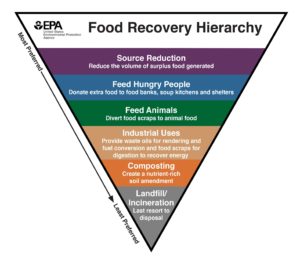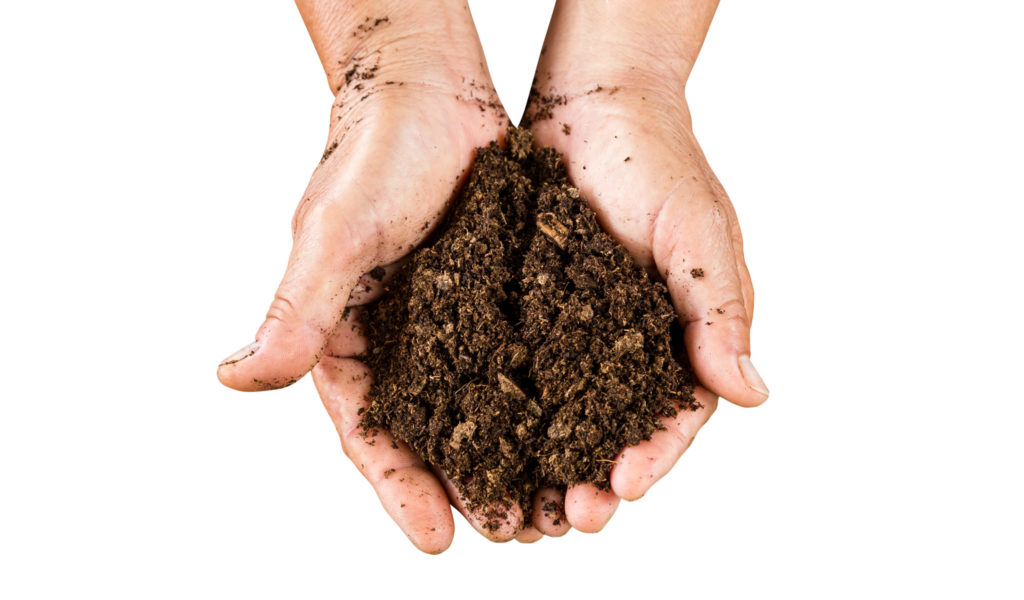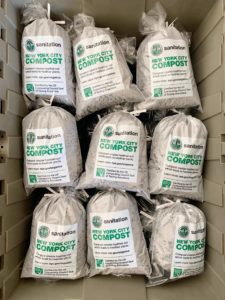In May this year, RTS joined forces with the Sanitation Foundation to bring together volunteers from around Staten Island to get their hands dirty with a little Black Gold! We firmly believe the program was a success, not only diverting organic waste from landfill but also providing education and awareness to those involved. With that in mind, here we explore the benefits of community composting and explain a little more about how RTS can help.
Organic waste is an inevitable part of the economy and most private households, but what we do with that waste can have a massive impact on our own carbon footprint, as well as the wider climate crisis. When organic waste is sent to landfill, as it so often is, it decomposes and releases methane, a harmful greenhouse gas.
Aside from the essential strategies and education targeted at reducing food waste in the first instance, composting is an invaluable solution to mitigate landfill-produced methane. Additionally, composting transforms organic waste into nutrient-rich fertilizer that can fuel the growth of new plants and food crops. While composting has long been a feature of American households, a newer phenomenon of community composting has seen this highly circular activity take root in local communities to the benefit of all.

What Do We Mean By Composting?
To recap, composting is the process by which green matter (e.g. vegetable cut offs), brown matter (e.g. leaves, cardboard) and air, combine to provoke decomposition. Together these elements decompose into compost in a few months. Compost is used to imbue soil with all the nutrients needed to grow additional food or nurture plants and ecosystems.
Whatsmore, composting reduces the need for synthetic fertilizers to be added to the earth, and when new plants grow, they help to offset the carbon released during composting. In this sense composting contributes significantly to the circular economy. But how does composting take shape at the level of the community, and how does this differ from time honored, backyard composting?
What Is Community Composting?
Conceptually, community composting is about taking the myriad benefits of composting and expanding them to the whole community. If traditional household composting centralizes the advantages of composting in a single home (with diminishing returns over time), and commercial composting realizes the benefits at large industrial facilities beyond our view, community composting seeks to spread the process and the benefits of so-called ‘black gold’ around a community.
Thus community composting creates a closed loop, whereby food waste from homes and/or businesses is gathered locally, usually via a sustainable mode of transport like bicycles, and brought to a nearby compost site or sites. Once local food scraps and organic waste have been processed at a site run by community members, the resultant compost is used to fertilize gardens and farms nearby, which in turn grow food to be sold and consumed in the local community.
What Are The Forms of Community Composting?
Community compost collection services pick up organic waste from households that have no facility to compost it alone, and distribute it locally to those households or farms that can. This model is similar to traditional home composting except we’re matching one home’s kitchen with another’s backyard.
It doesn’t require the planning and development of a new composting site, and yet succeeds in redirecting a great deal of organic waste from landfill while empowering communities. In places such as NYC where municipal compost collection services were put on pause, or in the many towns in the United States with no organic recycling scheme, this kind of compost collection enterprise is an invaluable step.
The natural successor to the above kind of scheme is the development of a shared community compost project, usually established within a public space such as a community garden. This is probably the most common community compost program.
Here, locals sign up to contribute their waste to a local compost site which is developed and managed by locals. This kind of scheme has the potential to compost greater volumes of waste and operate efficiently at scale by managing supply and demand centrally. A community garden compost heap also serves as a social hub and a learning center where locals can come together.
Benefits Of Community Composting
While there is a place for individual backyard compost heaps, and undoubtedly a need for large-scale centralized composting facilities, the benefits of community composting are unique and powerful.
First and foremost it can be designed and scaled to meet the unique needs of a specific community. On a social level, community composting differs greatly from individual or commercial composting in that it draws community members together by displaying the tangible benefits for all to see.
It is a great way to engage and facilitate education among community members – learning by doing is as meaningful an adage here as anywhere. It promotes learning around food systems, land stewardship, and sustainability. And suddenly food security becomes something that communities can affect with their own behavior. The visibility of community composting also has the potential to bring in diverse members of a community that may not otherwise consider composting and how it could benefit their lives.
Community composting ties the hard economic advantages of composting back to those who undertake it. Jobs are created by locals, for locals and all the economic gains are shared among them. Tasks such as storm water management and soil remediation are made easier. Better soil and better plant life in the community are aims that are often aligned with pre-established community goals, such as more greenspace and low pollution. To that same end, community composting also means reducing trash haulage in the local area which in turn means lower emissions.
That people can see the benefits of composting with their own eyes encourages ongoing participation and empowers individuals. Some community collection and distribution services have jumped on this by offering quantifiable feedback on your households’ compost.
For example, Compost Pedallers in Austin have an app that reports to the customer on how much organic waste has avoided landfill because of your efforts, how much methane has been contained, and the level of diesel emissions avoided. Statistics on how much finished compost is generated and how much money is saved by local growers due to a customer’s efforts inspires ongoing commitment to a scheme.
How To Start A Community Composting Program
As a firm believer in community composting, RTS recently partnered with the Sanitation Foundation to deliver its own compost bagging day. On 6th May 2022, 12 volunteers from Staten Island and the RTS team came together to bag more than 435lbs of compost ready for use in gardens, smallholdings, and farms. However, your community composting programme needn’t be overseen by outside organizations.
The beauty of community composting is that it can be scaled to your community’s capacities. A comprehensive approach to a new community composting project means gathering as much expertise and information as possible. Selecting the appropriate site for a community compost project is important and consultation should be made with experts if the project leads are not specialists themselves. Although becoming an expert in composting is clearly a good place to start!

Source: epa.gov
Effective planning and mapping out of a site should be undertaken well in advance of receiving your first loads of organic waste. Ensuring an adequate supply of greens and browns exists locally will allow you to balance your compost over time. Surveying and consulting community members first is not only an essential step to measure demand, but also an opportunity to garner initial interest from locals.
Communication is its own beast and will be integral to the success of a project. Only clear and concise information delivered to participants will ensure that you receive the green and brown matter you need for a healthy compost site. Remember, the primary goal should be achieving circularity, which can be successful on a small scale, rather than aiming for scale right from the start.
Much of the 40million tons of food that Americans waste each year could be redirected to hungry mouths. And while we should all be mindful that composting is the last step before landfill on the EPA’s food recovery hierarchy, composting remains a valuable weapon in the fight against climate change. Community composting effectively applies the logic of the circular economy to this age old, natural process. It has the ability to positively impact a community’s environmental footprint while offering hard benefits to the local economy and locals’ quality of life.
For more information on how individuals and businesses can reduce waste streams, subscribe to the RTS blog today. For tailored insights into your waste management practices, contact one of our LEED-accredited advisors.
If you want to learn more about responsible waste disposal and how your business can begin increasing diversion rates, then contact our TRUE advisors today to discuss your requirements and learn more about how to develop a healthier relationship with waste by subscribing to the RTS blog.


